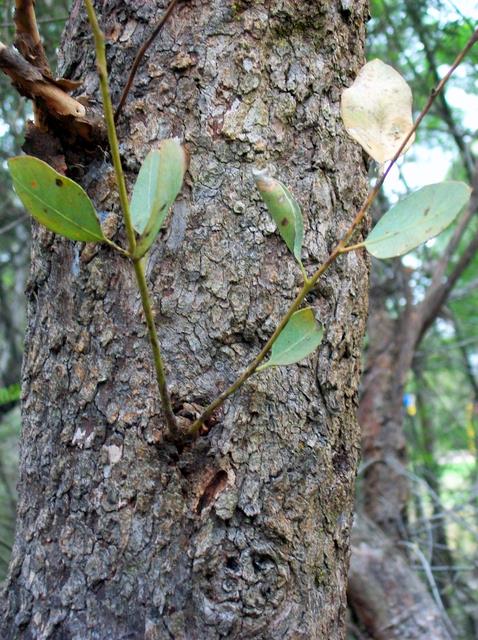Scaly Bark on:
[Wikipedia]
[Google]
[Amazon]

 ''Eucalyptus squamosa'', commonly known as scaly bark, is a species of small to medium-sized tree that is
''Eucalyptus squamosa'', commonly known as scaly bark, is a species of small to medium-sized tree that is

 ''Eucalyptus squamosa'', commonly known as scaly bark, is a species of small to medium-sized tree that is
''Eucalyptus squamosa'', commonly known as scaly bark, is a species of small to medium-sized tree that is endemic
Endemism is the state of a species being found in a single defined geographic location, such as an island, state, nation, country or other defined zone; organisms that are indigenous to a place are not endemic to it if they are also found elsew ...
to the Sydney region in New South Wales. It has rough, tessellated
A tessellation or tiling is the covering of a surface, often a plane, using one or more geometric shapes, called ''tiles'', with no overlaps and no gaps. In mathematics, tessellation can be generalized to higher dimensions and a variety of ge ...
, fibrous or flaky bark, lance-shaped or curved adult leaves, flower buds in groups of seven, nine or eleven, white flowers and cup-shaped or hemispherical fruit.
Description
''Eucalyptus squamosa'' is a tree that typically grows to a height of and forms alignotuber
A lignotuber is a woody swelling of the root crown possessed by some plants as a protection against destruction of the plant stem, such as by fire. Other woody plants may develop basal burls as a similar survival strategy, often as a response t ...
. It has rough, grey or reddish brown, tessellated fibrous or flaky bark on the trunk and branches. Young plants and coppice
Coppicing is a traditional method of woodland management which exploits the capacity of many species of trees to put out new shoots from their stump or roots if cut down. In a coppiced wood, which is called a copse, young tree stems are repeated ...
regrowth have dull green to greyish, egg-shaped leaves that are long and wide and petiolate
Petiole may refer to:
*Petiole (botany), the stalk of a leaf, attaching the blade to the stem
*Petiole (insect anatomy)
In entomology, petiole is the technical term for the narrow waist of some hymenopteran insects, especially ants, bees, a ...
. Adult leaves are arranged alternately, the same shade of green to greyish on both sides, lance-shaped to curved, long and wide, tapering to a petiole long. The flower buds are arranged in leaf axil
A leaf ( : leaves) is any of the principal appendages of a vascular plant stem, usually borne laterally aboveground and specialized for photosynthesis. Leaves are collectively called foliage, as in "autumn foliage", while the leaves, st ...
s in groups of seven, nine or eleven on paired peduncles long, the individual buds on pedicels
In botany, a pedicel is a stem that attaches a single flower to the inflorescence. Such inflorescences are described as ''pedicellate''.
Description
Pedicel refers to a structure connecting a single flower to its inflorescence. In the absenc ...
long. Mature buds are oval, long and wide with a conical to beaked operculum. Flowering occurs from October to December and the flowers are white. The fruit is a woody cup-shaped or hemispherical capsule long and wide with the valves protruding strongly.
Taxonomy and naming
''Eucalyptus squamosa'' was first formally described in 1898 byJoseph Maiden
Joseph Henry Maiden (25 April 1859 – 16 November 1925) was a botanist who made a major contribution to knowledge of the Australian flora, especially the genus ''Eucalyptus''. This botanist is denoted by the author abbreviation when citing ...
and Henry Deane in ''Proceedings of the Linnean Society of New South Wales
The Linnean Society of New South Wales promotes ''the Cultivation and Study of the Science of Natural History in all its Branches'' and was founded in Sydney, New South Wales ( Australia) in 1874 and incorporated in 1884.
History
The Society suc ...
''. The specific epithet
In taxonomy, binomial nomenclature ("two-term naming system"), also called nomenclature ("two-name naming system") or binary nomenclature, is a formal system of naming species of living things by giving each a name composed of two parts, bot ...
(''squamosa'') is from the Latin
Latin (, or , ) is a classical language belonging to the Italic branch of the Indo-European languages. Latin was originally a dialect spoken in the lower Tiber area (then known as Latium) around present-day Rome, but through the power of the ...
word ''squamosus'', meaning "scaly", referring to the bark of this species.
Distribution and habitat
Scaly bark grows in sclerophyll woodland, where soil accumulates in depressions on the sandstone on and around sandstone plateaus, often onlateritic
Laterite is both a soil and a rock type rich in iron and aluminium and is commonly considered to have formed in hot and wet tropical areas. Nearly all laterites are of rusty-red coloration, because of high iron oxide content. They develop by ...
soils. It occurs in the Sydney
Sydney ( ) is the capital city of the state of New South Wales, and the most populous city in both Australia and Oceania. Located on Australia's east coast, the metropolis surrounds Sydney Harbour and extends about towards the Blue Mountain ...
region, between the Putty
Putty is a material with high plasticity, similar in texture to clay or dough, typically used in domestic construction and repair as a sealant or filler. Although some types of putty (typically those using linseed oil) slowly polymerise and be ...
and Broke districts and the Royal National Park
The Royal National Park is a protected national park that is located in Sutherland Shire in the Australian state of New South Wales, just south of Sydney.
The national park is about south of the Sydney central business district near the local ...
.
References
{{Taxonbar, from=Q5405720 squamosa Myrtales of Australia Flora of New South Wales Trees of Australia Plants described in 1898